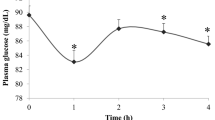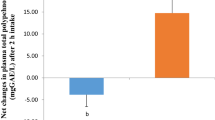Abstract
The mutual influences of wheat selenium (Se) andn-3 polyunsaturated fatty acids(n- 3 PUFA) on plasma Se and indicators of increased oxidative stress were investigated in a randomized, doubleblind study with 31 women (23.5 ±3.4 yr). Groups 1 and 2 ingested 5.4 g n-3 PUFA daily (as ethyl esters), whereas groups 3 and 4 received placebo capsules. Groups 2 and 3 received 3 slices of high Se bread daily, providing 115 Μg Se, in addition to the 77± 26 ug Se in the diet. Groups 1 and 4 received placebo slices. Blood samples were drawn at baseline and at 3 and 6 wk.
Serum Se concentrations increased in both groups given Seenriched bread, but significantly less in subjects givenn-3 PUFA (group 2). There were no changes in the plasma ratio α-tocopherol:mg cholesterol or plasma ascorbic acid levels. In group1, plasmaconjugated dienes and thiobarbituric acid-reactive substances (TBARS) rose by 130% (p < 0.005) and 126% (p < 0.005), respectively. Two-way ANOVA showed significant interaction effects of Se andn-3 PUFA on changes in conjugated dienes (p = 0.03) and TBARS (p = 0.015), Se treatment apparently modifying the peroxidative effects ofn-3 PUFA. In subjects receivingn-3 PUFA, changes in conjugated dienes and TBARS were negatively correlated with changes in serum Se. In summary,n-3 PUFA modified the effect of Se supplementation, whereas Se seemed to modify the peroxidative effects ofn-3 PUFA.
Similar content being viewed by others
References
H. O. Bang, J. Dyerberg, and H. M. Sinclair, Plasma lipids and lipoproteins in Greenlandic west coast Eskimos,Acta Med. Scand. 192, 85–94 (1972).
D. Kromhout, E. B. Bosschieter, and C. de L. Coulander, The inverse relation between fish consumption and 20-year mortality from coronary heart disease,N. Engl. J. Med. 312, 1205–1209 (1985).
P. M. Herold and J. E. Kinsella, Fish oil consumption and decreased risk of cardiovascular disease: a comparison of findings from animal and human feeding trials,Am. J. Clin. Nutr. 43, 566–598 (1986).
J. T. Salonen, G. Alfthan, J. K. Huttunen, J. Pikkarainen, and P. Puska, Association between cardiovascular death and myocardial infarction and serum selenium in a matched pair longitudinal study,Lancet ii, 175–179 (1982).
G. Hampel, K. Watanabe, B. B. Weksler, and E. A. Jaffe, Selenium deficiency inhibits prostacyclin release and enhances production of platelet activating factor by human endothelial cells,Biochem. Biophys. Acta 1006, 151–158 (1989).
G. Perona, R. Schiavon, G. C. Guidi, D. Veneri, and P. Minuz, Selenium dependent glutathione peroxidase: a physiological regulatory system for platelet function,Thromb. Haemost. 64, 312–318 (1990).
J. G. Bieri, S. L. Thorp, and T. J. Tolliver. Effect of dietary polyunsaturated fatty acids on tissue vitamin E status,J. Nutr. 108, 392–398 (1978).
M. Chautan, R. Calaf, J. Leonardi, M. Charbonnier, M. Andre, H. Portugal, A.-M. Pauli, H. Lafont, and G. Nalbone, Inverse modifications of heart and liver alpha-tocopherol status by various dietary n-6/n-3 polyunsaturated fatty acid ratios,J. Lipid Res. 31, 2201–2208 (1990).
R. Bach, U. Schmidt, F. Jung, H. Kiesewetter, B. Hennen, E. Wenzel, H. Schieffer, L. Bette, and S. Heyden, Effects of fish oil capsules in two dosages on blood pressure, platelet functions, haemorheological and clinical chemistry parameters in apparently healthy subjects,Ann. Nutr. Metab. 33, 359–367 (1989).
A. BjØrneboe, A. K. Smith, G.-E. Aa. BjØrneboe, P. O. Thune, and C. A. Drevon, Effects of dietary supplementation with n-3 acids on clinical manifestations of psoriases,Br. J. Dermatol. 118, 77–83 (1988).
P. P. Nair, J. T. Judd, and E. Berlin, Dietary fish oil-induced changes in the distribution of (α-tocopherol, retinol, and beta-carotene in plasma, red blood cells, and platelets: modulation by vitamin E,Am. J. Clin. Nutr. 58, 98–102 (1993).
E. Cabre, J. L. Periago, M. D. Mingorance, F. Fernandez-Banares, A. Abad, M. Esteve, A. Gil, M. Lachica, F. Gonzalez-Huix, and M. A. Gassull, Factors related to the plasma fatty acid profile in healthy subjects, with special reference to antioxidant micronutrient status,Am. J. Clin. Nutr. 55, 831–837 (1992).
G. Bellisola, S. Galassini, G. McSchini, G. Poli, G. Perona, and G. Guidi, Selenium and GSH-Px variations induced by polyunsaturated fatty acid oral supplementation in humans,Clin. Chim. Acta 205, 75–85 (1992).
A. R. Alexander, P. D. Whanger, and L. T. Miller, Bioavailability to rats of selenium in various tuna and wheat products,J. Nutr. 113, 196–204 (1983).
J. S. Douglass, V. C. Morris, J. H. Soares, and O. A. Levander, Nutritional availability to rats of selenium in tuna, beef kidney, and wheat,J. Nutr. 111, 2180–2187 (1981).
M. Mutanen, P. Koivistoinen, V. C. Morris, and O. A. Levander, Nutritional availability to rats of selenium in four seafoods: crab, oyster, shrimp and Baltic herring,Br. J. Nutr. 55, 219–225 (1986).
E. R. Knudsen, M. Lorenzen and K. Julshamn, Biological availability to rats of selenium from cod (Gadus morhua) and selenomethionine relative to sodium selenite,Fisk. Dir. Skr. Ser. ErnÆring (The Directorate of Fisheries, Bergen, Norway) 5, 111–120 (1992).
C. von Schacky and P. C. Weber, Metabolism and effects of platelet function of the purified eicosapentaenoic and docosahexaenoic acids in humans,J. Clin. Invest. 76, 24446–50 (1985).
T. Hamazaki, M. Urakatze, M. Makuta, A. Ozawa, Y. Soda, H. Tatsumi, S. Yano, and A. Kumagai, Intake of different eicosapentaenoic acid-containing lipids and fatty acid pattern of plasma lipids in the rat,Lipids 22, 994–998 (1987).
A. NordØy, L. Barstad, W. E. Connor, and L. Hatcher, Absorption of the n-3 eico sapentaenoic and docosahexaenoic acids as ethyl esters and triglycerides by humans,Am. J. Clin. Nutr. 53, 1185–1190 (1991).
J. B. Hansen, J. O. Olsen, L. Wilsgård, V. Lyngmo, and B. Svensson, Comparative effects of prolonged intake of highly purified fish oils as ethyl ester or triglyceride on lipids, haemostasis and platelet function in normolipaemic men,Eur. J. Clin. Nutr. 47, 497–507 (1993).
Norwegian Nutrition Council, Food Composition Tables. Published by the Norwegian Nutrition Council, Oslo, Norway (1984).
Ø. Lie, E. Lied and G. Lambertsen, Haematological values and fatty acid composition of erythrocyte phospholipids in cod (Gadus morhua) fed at different water temperatures,Aquaculture 79, 137–144 (1989).
Ø. Lie, G.-I. Hemre, and G. Lambertsen, Influence of dietary fatty acids on the glycerophospholipid composition in organs of cod (Gadus morhua),Lipids 27, 770–775 (1992).
W. T. Friedewald, R. J. Levy, and D. S. Fredrickson, Estimation of the concentration of low-density lipoprotein cholesterol in plasma without use of the preparative ultracentrifuge,Clin. Chem. 18, 499–502 (1972).
Ø Lie, A. Sandvin, and R. WaagbØ, Transport of α-tocopherol in Atlantic salmon (Salmo salar) during vitellogenesis,Fish Physiol. Biochem. 13, 241–247 (1994).
S. Wang, I. M. SchrÄm, and R. B. Sund, Determination of plasma ascorbic acid by HPLC-method and stability studies,Eur. J. Pharm. Sci. 3, 231–239 (1995).
J. Folch, M. Lees, and G. H. Stanley, A simple method for the isolation and purification of total lipids from animal tissues,J. Biol. Chem. 226, 497–509 (1957).
W. A. Pryor and L. Castle, Chemical methods for detection of lipid peroxidation,Methods Enzymol. 105, 292–299 (1984).
A. Maage, K. Julshamn, and K. J. Andersen, Determination of selenium in acid digested marine samples by electrothermal atom absorption spectrometry with continuum source background correction and nickel as a chemical modifier,J. Anal. Atomic Spectrom. 6, 277–281 (1991).
H. M. Meltzer, G. Norheim, K. Bibow, K. Myhre, and H. Holm, The form of selenium determines the response to supplementation in a selenium replete population,Eur. J. Clin. Nutr. 44, 435–446 (1990).
H. M. Meltzer, K. Bibow, I. T. Paulsen, H. Mundal, G. Norheim, and H. Holm, Different bioavailability in humans of wheat and fish selenium as measured by blood platelet response to increased dietary Se,Biol. Trace Element Res. 36, 229–41 (1993).
Recommended Dietary Allowances, 10th ed. Nutritional Research Council, National Academy Press, Washington DC (1989).
P. L. Harris and N. D. Embree, Quantitative consideration of the effect of polyunsaturated fatty acid content of the diet upon the requirements for vitamin E,Am. J. Clin. Nutr. 13, 385–392 (1963).
J. E. Brown and K. W. J. Wahle, Effect of fishoil and vitamin E supplementation on lipid peroxidation and whole-blood aggregation in man,Clin. Chim. Acta 193, 147–156 (1990).
W. W. Kim, W. Mertz, J. T. Judd, M. W. Marshall, J. L. Kelsay, and E. S. Prather, Effect of making duplicate collections of nutrient intakes calculated from diet records,Am. J. Clin. Nutr. 40, 1333–1337 (1984).
B. A. Isaksson, A critical evaluation of the duplicate-portion technique in dietary surveys,Eur. J. Clin. Nutr. 47, 457–460 (1993).
L. ScjÄfer and E. B. Thorling, Lipid peroxidation and antioxidant supplementation in old age,Scand. J. Clin. Lab. Invest. 50, 69–75 (1990).
J. B. Hansen, L. NordbØ Berge, B. Svensson, V. Lyngmo, and A. NordØy. Effects of cod liver oil on lipids and platelets in males and females,Eur. J. Clin. Nutr. 47, 123–131 (1993).
M. Meydani, F. Natiello, B. Goldin, N. Free, M. Woods, E. Schaefer, J. Blumberg, and S. L. Gorbach, Effect of long-term fish-oil supplementation on vitamin E status and lipid peroxidation in women,J. Nutr. 121, 484–491 (1991).
B. Halliwell and J. M. C. Gutteridge,Free Radicals in Biology and Medicine. 2nd ed., Clarendol, Oxford 1989.
R. F. Burk and K. E. Hill, Regulation of selenoproteins,Ann. Rev. Nutr. 13, 65–81 (1993).
R. F. Burk, R. A. Lawrence, and J. M. Lane, Liver necrosis and lipid peroxidation in the rat as the result of paraquat and diquat administration,J. Clin. Invest 65, 1024–1031 (1980).
W. C. Willett, B. F. Polk, J. S. Morris, M. J. Stampfer, S. Pressel, B. Rosner, J. O. Taylor, K. Schneider, and C. G. Hames, Prediagnostic serum selenium and risk of cancer,Lancet 16, 130–134 (1983).
H. W: Lane, D.C. Warren, E. Martin, and J. McCowan, Selenium status of industrial worker,Nutr. Res. 3, 805–817 (1983).
Author information
Authors and Affiliations
Rights and permissions
About this article
Cite this article
Meltzer, H.M., Folmer, M., Wang, S. et al. Supplementary selenium influences the response to fatty acid-induced oxidative stress in humans. Biol Trace Elem Res 60, 51–68 (1997). https://doi.org/10.1007/BF02783309
Received:
Accepted:
Issue Date:
DOI: https://doi.org/10.1007/BF02783309




